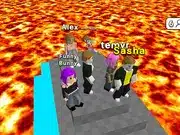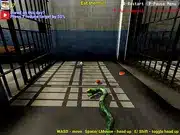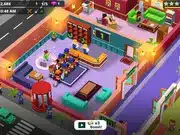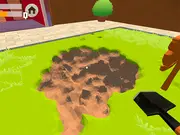That’s Not My Neighbor
About That’s Not My Neighbor
There’s a new kind of tension brewing in the gaming world – a nail-biting, side-splitting, identity-confirming kind of tension. Forget sprawling fantasy worlds and epic space battles; the real thrill comes from staring into the unsettlingly familiar faces peering back at you and deciding if they’re truly your neighbor…or something far more sinister. This isn’t just a game; it’s a high-stakes immigration sim with a healthy dose of paranoia, and it’s become an instant obsession.
It’s not just the retro graphics or the unsettling sound design, but the sheer, distilled anxiety of the gatekeeper, the one responsible for keeping the abnormal out. Every wrong answer has consequences, every unchecked detail could mean the end of everything familiar. Players are hooked on the adrenaline rush of making those split-second decisions, the constant fear of failing, and the sweet, sweet relief of catching an imposter right under their nose.
About That’s Not My Neighbor
At its core, *That’s Not My Neighbor* plunges you into the role of a doorman at a seemingly normal apartment building. However, beneath the veneer of everyday life lurks a terrifying secret: Doppelgangers, or “Alternates,” are attempting to infiltrate society, disguised as ordinary citizens. Your job, as the vigilant guardian of the building’s entrance, is to meticulously scrutinize each applicant, poring over their documents and observing their mannerisms to determine whether they are who they claim to be. Imagine a job interview, but the stakes are the very fabric of reality.
The gameplay is deceptively simple. Each prospective tenant approaches the building, presenting various forms of identification: applications, permits, and even seemingly innocuous pieces of mail. You must carefully examine these documents for discrepancies, inconsistencies, or telltale signs of forgery. Cross-referencing information, paying close attention to details like birthdates, signatures, and even the color of their eyes becomes crucial. But the challenge doesn’t end there. These Alternates are cunning, and their disguises are often remarkably convincing. You must also observe their behavior, looking for subtle clues that betray their true nature. A nervous tic, an oddly worded response, or an unsettlingly blank stare could be all the evidence you need to deny them entry.
What sets *That’s Not My Neighbor* apart is its focus on psychological tension. The game masterfully creates an atmosphere of dread and suspicion, leaving you constantly second-guessing yourself. Is that slight discrepancy in their paperwork just a harmless error, or a deliberate attempt to deceive you? Is that unsettling smile simply a sign of awkwardness, or a mask concealing something far more sinister? The weight of responsibility rests solely on your shoulders, and the consequences of failure are dire. The game’s retro aesthetic and unsettling sound design further amplify the sense of unease, creating a truly immersive and unforgettable experience.
Prepare to be engrossed in a world where trust is a luxury you can’t afford. Every interaction is a calculated risk, every decision could be your last. Step into the booth, brace yourself for the scrutiny, and get ready to decide who’s welcome and who’s not in this addictive and unsettling game.
How to Play That’s Not My Neighbor
Your workstation is the control panel, your eyes are the gatekeepers, and your judgment is the only thing standing between normalcy and chaos. *That’s Not My Neighbor* hinges on meticulous observation and quick decision-making. Each applicant stands before you, their documents displayed on the left side of the screen. The right side features your control panel with stamps, rejection slips, and crucial communication devices. Let’s break it down, step-by-step:
First, you’ll see the applicant and their documents. Use **Left-Click** to cycle through each document. Pay close attention to the name, ID number, date of birth, address, and any other identifying information. Use **Left-Click** again on specific sections of the document to zoom in for closer inspection. Certain documents will have security features like watermarks or holograms; make sure these are present and authentic. Next, observe the applicant’s appearance. Check their hair color, eye color, and any distinguishing marks against the information provided. Look for inconsistencies! Do they match the description? Does their demeanor feel off? This is where intuition comes into play.
Next comes the verification process. The control panel has several key functions accessible through specific controls. The “Call Supervisor” button (activated by pressing the **”C” key**) allows you to consult with your superior for clarification on ambiguous cases. The “Identity Scanner” (activated by pressing the **”I” key**) uses a high-tech device to verify the applicant’s identity. Be aware that this scanner has limited uses each day, so use it wisely. If you find any discrepancies or suspect an Alternate, you can deny entry by pressing the **”D” key**. This triggers the security system, preventing the applicant from entering the building. If everything checks out, and you’re confident in your assessment, you can approve entry by pressing the **”A” key**. This opens the gate, allowing the applicant to proceed. Incorrectly identifying a human has consequences! Each wrong decision will affect your performance and the overall safety of the building. The ultimate goal is to maintain order, protect the residents, and survive each shift without succumbing to the paranoia.
Beginner tip: Don’t rush! Take your time to carefully examine each document and observe the applicant’s behavior. Early in the game, practice using the Identity Scanner and the Call Supervisor function to familiarize yourself with their capabilities. Most importantly, trust your instincts. If something feels off, it probably is. The fate of your neighbors depends on it.
What Makes That’s Not My Neighbor Special
*That’s Not My Neighbor* isn’t just another indie horror game; it’s a masterclass in building tension and creating a truly unique gaming experience. Its standout features are what keep players coming back for more, night after night.
- The Unsettling Atmosphere: From the grainy visuals to the eerie sound design, every element of the game contributes to a palpable sense of dread. The silence is punctuated by unsettling whispers and the occasional jarring jump scare, keeping you on edge.
- The Deceptive Doppelgangers: These aren’t your typical monsters. The Alternates are masters of disguise, making it incredibly difficult to discern them from ordinary humans. Their subtle inconsistencies and unsettling behavior create a constant sense of paranoia.
- The Weight of Responsibility: Your decisions have real consequences. Every approval or denial affects the safety of the building’s residents, adding a layer of moral complexity to the gameplay.
- The Mind-Bending Puzzles: The game throws a variety of challenges your way, from deciphering cryptic documents to solving logic puzzles under pressure. Keeping your mind sharp is a critical survival skill.
- The Retro Aesthetic: The game’s low-resolution graphics and 1980s-inspired design create a nostalgic yet unsettling atmosphere, reminiscent of classic horror films.
- The Simple Yet Addictive Gameplay: The core mechanics are easy to learn but difficult to master. The game’s addictive nature lies in the constant challenge of identifying the Alternates and protecting your neighbors.
- The Strategic Resource Management: You have limited resources at your disposal, such as the Identity Scanner and the ability to call your supervisor. Using these resources wisely is crucial for success.
- The Surprising Storyline: While the gameplay is primarily focused on identifying Alternates, a deeper narrative unfolds as you progress, revealing the secrets of the building and the nature of the threat.
- The Replayability Factor: The game’s randomized elements and multiple endings ensure that each playthrough is unique, keeping you coming back for more.
- The Community Interaction: The game has fostered a vibrant community of players who share strategies, theories, and fan art, adding to the overall experience.
All of these features combine to create a game that is both terrifying and addictive. *That’s Not My Neighbor* offers a unique blend of horror, puzzle-solving, and resource management, making it a truly unforgettable gaming experience.
Mastering That’s Not My Neighbor
So, you’ve survived a few shifts, but the Alternates are getting smarter, the documents are becoming more complex, and the paranoia is setting in. It’s time to elevate your gatekeeping game. Here are some advanced strategies to help you master *That’s Not My Neighbor* and become a true guardian of the building:
1. **Develop a Document Checklist:** Create a mental checklist of key details to look for on each document. This will help you quickly identify inconsistencies and potential forgeries. 2. **Master the ID Scanner:** Learn the subtle differences between a genuine ID and a fake. Pay attention to the scanner’s readings and look for anomalies. 3. **Listen Carefully During Calls:** When you call your supervisor, pay close attention to their tone of voice and the information they provide. They may offer subtle clues that can help you identify Alternates. 4. **Trust Your Gut:** If something feels off about an applicant, even if you can’t pinpoint a specific reason, trust your instincts. It’s better to be safe than sorry. 5. **Recognize Common Alternate Tactics:** Alternates often employ specific tactics to deceive you, such as providing incomplete information, using forged documents, or exhibiting nervous behavior. Learn to recognize these tactics and be prepared to counter them. 6. **Optimize Resource Usage:** Use your resources wisely, particularly the Identity Scanner. Save it for the most suspicious applicants and avoid wasting it on obvious cases. 7. **Learn the Lore:** Pay attention to the game’s lore and backstory. Understanding the nature of the Alternates and their motivations can help you make better decisions. 8. **Memorize Faces:** As you encounter different applicants, try to memorize their faces. This will help you identify recurring characters and potential threats. 9. **Experiment with Different Strategies:** Don’t be afraid to experiment with different strategies and approaches. The best way to master the game is to find what works best for you. 10. **Join the Community:** Connect with other players online to share tips, strategies, and theories. The community is a valuable resource for learning and improving your skills.
By implementing these strategies, you can significantly improve your chances of survival and become a true master of *That’s Not My Neighbor*. Remember, vigilance is key, and the fate of your neighbors rests in your hands.
Different Ways to Play
*That’s Not My Neighbor* offers a single, intensely focused gameplay mode, but its replayability is fueled by the unpredictable nature of the Alternates and the increasing difficulty as you progress. Each shift presents a unique set of challenges, forcing you to adapt your strategies and stay on your toes. The game doesn’t have traditional “difficulty levels” in the conventional sense, but the frequency and complexity of the Alternates’ disguises steadily increase, demanding greater attention to detail and faster decision-making.
The game’s progression system is subtle but effective. As you successfully identify and deny entry to Alternates, you unlock new pieces of the story, revealing more about the building’s secrets and the nature of the threat. This narrative progression provides a sense of accomplishment and motivates you to keep playing, even when the challenges become increasingly daunting. Furthermore, the game features multiple endings, depending on your choices and actions throughout the playthrough. This encourages you to experiment with different strategies and approaches to see how they affect the outcome. The constant influx of new applicants, the increasing difficulty, and the multiple endings ensure that *That’s Not My Neighbor* offers a high degree of replay value, keeping you engaged and entertained for hours on end.
What Makes This Game Addictive
Beyond the jump scares and unsettling visuals, *That’s Not My Neighbor* taps into a deeper psychological appeal. It plays on our innate fear of the unknown and our desire for control in a chaotic world. The game puts you in a position of authority, giving you the power to decide who is allowed to enter your domain, and who is not. This sense of control, however, is constantly challenged by the cunning and deceptive nature of the Alternates, creating a thrilling cat-and-mouse game that keeps you on the edge of your seat.
It’s the constant state of heightened awareness that really hooks you. Every detail matters, every interaction is a potential trap. “I found myself meticulously comparing birthdates, squinting at blurry passport photos, and even analyzing the way they stood! It’s like being a detective in a low-budget horror movie,” says one ‘player’ (of course, only in a fictional game universe!). “The moment you catch an Alternate trying to slip past you is incredibly satisfying. It’s like you’ve outsmarted the devil himself.” *That’s Not My Neighbor* provides a potent mix of anxiety, suspense, and triumph, making it a truly addictive gaming experience.
Is That’s Not My Neighbor Right For You?
*That’s Not My Neighbor* is perfect for players who enjoy psychological horror, puzzle-solving, and resource management. If you’re a fan of games that rely on atmosphere and tension rather than gore and violence, this game is definitely worth checking out. The game’s difficulty level is moderate, making it accessible to both casual and hardcore gamers. However, it requires a high degree of attention to detail and a willingness to think critically under pressure. While there are no specific age recommendations, the game’s unsettling themes and occasional jump scares may not be suitable for younger children.
If you enjoy games like *Papers, Please* or *Contradiction*, *That’s Not My Neighbor* will likely appeal to you. However, the game’s focus on horror and psychological tension sets it apart from similar titles. While the learning curve is relatively gentle, the game’s increasing difficulty and complex puzzles will challenge even experienced gamers. *That’s Not My Neighbor* is a great choice for players who enjoy a unique and immersive gaming experience that will keep them on the edge of their seats.
Why You Should Play That’s Not My Neighbor Today
*That’s Not My Neighbor* is more than just a game; it’s a masterclass in suspense, a thrilling exercise in observation, and a chilling reminder that things are not always what they seem. Its unique blend of horror, puzzle-solving, and resource management creates a truly unforgettable gaming experience that will keep you hooked from start to finish.
So, if you’re looking for a game that will challenge your mind, test your nerves, and leave you questioning everything you thought you knew, look no further. Dive into the unsettling world of *That’s Not My Neighbor*, sharpen your senses, and prepare to defend your building from the forces of the unknown. Don’t wait, the safety of your neighborhood depends on you – play *That’s Not My Neighbor game* today and uncover the secrets that lie within!







